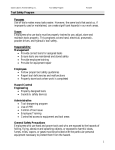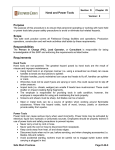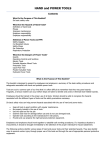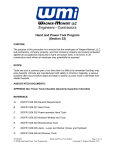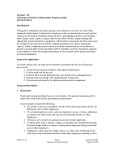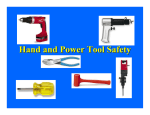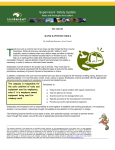Download Safety Clips - Arizona Masonry Contractors Association
Transcript
Safety Clips Issue 12 April 2010 AMCA Supporting its Association Safety Plan Arizona Masonry Contractors Association Hand and Power Tools Safety Tools are such a common part of our lives that it is difficult to remember that they may pose hazards. Tragically, a serious incident can occur before steps are taken to identify and avoid or eliminate tool-related hazards. Employees who use hand and power tools and are exposed to the hazards of falling, flying, abrasive, and splashing objects, or to harmful dusts, fumes, mists, vapors, or gases must be provided with the appropriate personal protective equipment. All electrical connections for these tools must be suitable for the type of tool and the working conditions (wet, dusty, flammable vapors). When a temporary power source is used for construction a ground-fault circuit interrupter should be used. Employees should be trained in the proper use of all tools. Workers should be able to recognize the hazards associated with the different types of tools and the safety precautions necessary. Five basic safety rules can help prevent hazards associated with the use of hand and power tools: · · · · · Keep all tools in good condition with regular maintenance. Use the right tool for the job. Examine each tool for damage before use and do not use damaged tools. Operate tools according to the manufacturers' instructions. Provide and use properly the right personal protective equipment. Employees and employers should work together to establish safe working procedures. If a hazardous situation is encountered, it should be brought immediately to the attention of the proper individual for hazard abatement. Following is an overview of the hazards and dangers of hand and power tools. Hazards of Hand Tools Hand tools are tools that are powered manually. Hand tools include anything from axes to wrenches. The greatest hazards posed by hand tools result from misuse and improper maintenance. Some examples include the following: · If a chisel is used as a screwdriver, the tip of the chisel may break and fly off, hitting the user or other employees. · If a wooden handle on a tool, such as a hammer or an axe, is loose, splintered, or cracked, the head of the tool may fly off and strike the user or other employees. · If the jaws of a wrench are sprung, the wrench might slip. · If impact tools such as chisels, wedges, or drift pins have mushroomed heads, the heads might shatter on impact, sending sharp fragments flying toward the user or other employees. The employer is responsible for the safe condition of tools and equipment used by employees. Employers shall not issue or permit the use of unsafe hand tools. Employees should be trained in the proper use and handling of tools and equipment. Employees, when using saw blades, knives, or other tools, should direct the tools away from aisle areas and away from other employees working in close proximity. Knives and scissors must be sharp; dull tools can cause more hazards than sharp ones. Cracked saw blades must be removed from service. Wrenches must not be used when jaws are sprung to the point that slippage occurs. Impact tools such as drift pins, wedges, and chisels must be kept free of mushroomed heads. The wooden handles of tools must not be splintered. Iron or steel hand tools may produce sparks that can be an ignition source around flammable substances. Where this hazard exists, spark-resistant tools made of non-ferrous materials should be used where flammable gases, highly volatile liquids, and other explosive substances are stored or used. Dangers of Power Tools Appropriate personal protective equipment such as safety goggles and gloves must be worn to protect against hazards that may be encountered while using hand tools. Workplace floors shall be kept as clean and dry as possible to prevent accidental slips with or around dangerous hand tools. Power tools must be fitted with guards and safety switches; they are extremely hazardous when used improperly. The types of power tools are determined by their power source: electric, pneumatic, liquid fuel, hydraulic, and powder-actuated. To prevent hazards associated with the use of power tools, workers should observe the following general precautions: · Never carry a tool by the cord or hose. · Never yank the cord or the hose to disconnect it from the receptacle. · Keep cords and hoses away from heat, oil, and sharp edges. · Disconnect tools when not using them, before servicing and cleaning them, and when changing accessories such as blades, bits, and cutters. · Keep all people not involved with the work at a safe distance from the work area. · Secure work with clamps or a vise, freeing both hands to operate the tool. · Avoid accidental starting. Do not hold fingers on the switch button while carrying a plugged-in tool. · Maintain tools with care; keep them sharp and clean for best performance. · Follow instructions in the user's manual for lubricating and changing accessories. · Be sure to keep good footing and maintain good balance when operating power tools. · Wear proper apparel for the task. Loose clothing, ties, or jewelry can become caught in moving parts. · Remove all damaged portable electric tools from use and tag them: "Do Not Use." AMCA's Safety Committee is committed to providing support in your efforts to keep your employees safe and healthy. Safety Clips can be used in any number of ways: toolbox training sessions, company newsletter article or used as an opener for discussions in manager/supervisor's meetings, etc. Safety Clips is a means to keep safety topics fresh and in the forefront of your busy days and to make it easier for you to turn around and share with others in your company. If there are additional email addresses you'd like to add to the distribution list forward them to [email protected].




